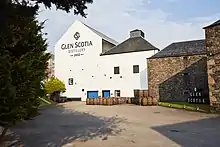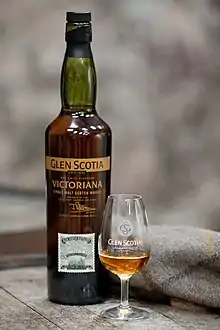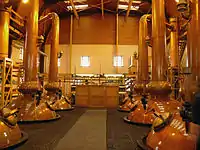Glen Scotia distillery
Glen Scotia distillery or sometimes affectionately known as The Scotia or Old Scotia is a distillery that is a producer of single malt Scotch whisky. The distillery was founded in 1832 and is one of just three distilleries left in Campbeltown, the smallest whisky region.[1]
 Glen Scotia Distillery | |
| Region: Campbeltown | |
|---|---|
| Owner | Loch Lomond Group |
| Founded | 1832 |
| Status | Operational |
| Water source | Crosshill Loch |
| No. of stills | 1 wash (16,000 l), 1 spirit (12,000 l)[2] |
| Capacity | 600,000 litres |
| Glen Scotia | |
| Age(s) | Double Cask 46% ABV
15 Year Old 46% ABV Victoriana 52.2% ABV 18 Year Old 46% ABV 25 Year Old 48.8% |

History
Glen Scotia Distillery was founded in 1832, and has been operating for one hundred and eighty years. Situated in Campbeltown, one of the recognised 5 Whisky producing regions of Scotland,[3] the distillery has a formidable pedigree.[4]
Campbeltown is a small town on the Kintyre Peninsula on the west coast of Scotland. It is affectionately known as the “Wee Toon”, and the Victorian Whisky Capital of the World. At its peak in the 1800s, there were 21 distilleries in this small town with approximately 170 distilleries operating at that time in the UK (129 of those in Scotland) Campbeltown still has 3 operating distilleries: Glen Scotia, Springbank, and Glengyle. These distilleries give a remarkable insight into the history of making whisky in this remote, once prolific, whisky making region of Scotland.
Glen Scotia was formerly known as 'Scotia' when it was first founded in 1832 by Stewart & Galbraith and Company. Stewart & Galbraith Co. ran the Distillery for almost 60 years. Notable industrialist Duncan MacCallum purchased the distillery in 1891 and he constructed the large frontage (Malting Floors) which run along High Street. In 2014, the distillery was bought by Loch Lomond Group who have invested heavily in the site by developing the brand, increasing capacity, opening warehouses and developing a distillery visitor centre.
Today, the distillery still maintains much of its original design, including the mashtun, the stillroom and the dunnage warehouse which dates back to the 1830s. Glen Scotia distillery currently operates with a staff of just 8 employees: one distillery manager, assistant distillery manager, visitor centre manager and five distillery operators. The visitor centre is open to the public and runs daily distillery tours and tastings, with a Victorian style shop to purchase the whisky, branded merchandise and other goods.
Product Range
The Glen Scotia range has been simplified down to five core Single Malt expressions:
- Double Cask - 46% ABV
- 15 Year Old - 46% ABV
- Victoriana - 54.2% ABV
- 18 Year Old - 46% ABV
- 25 Year Old - 48.8% ABV
Glen Scotia's range showcases the typical Campbeltown flavour profile of toffee, maritime influence and a hint of smoke.


Each of the core expressions have been designed to keep to an authentic 'Campbeltown Malt style' culminating in the Victoriana where the distillery has aimed to re-create a modern interpretation of classic Victorian Campbeltown Malt. Glen Scotia Distillery also regularly produces 'special' bottlings to celebrate local events, such as the centenary anniversary of the local Campbeltown Picture House.
Each year, for the annual Campbeltown Malt Whisky Festival, Glen Scotia release a special limited release bottling. In 2019 this was a 15 year old rum finish and 2020 a 14 year old Tawny Port finish.
Additionally, special releases and other small production run bottlings also exist.
Production
The distillery draws its water from Crosshill Loch in Campbeltown.
The malt barley used is lightly peated, which gives a slight smokiness to the whisky.
Glen Scotia has one wash still, with a capacity of 16,000 litres, and one spirit still with a 12,000 litre capacity. The pot stills are onion shaped, with wide and short necks.
There are 9 washbacks within the distillery, these are all stainless steel. The washbacks that Glen Scotia originally had were more than 40 years old and were made out of Corton Steel.
The current annual production levels stand at around 500,000 litres.
Awards
Glen Scotia’s whiskies have been recognised in many renowned award ceremonies, such as San Francisco World Spirits Awards, International Wine & Spirits Competition, World Whisky Awards, International Spirits Challenge & The Scotch Whisky Masters.
| Awards Received | |||
|---|---|---|---|
| Double Cask | Gold Medal - San Francisco World Spirit Awards 2020 | Best Campbeltown Malt - World Whisky Awards 2020 | Gold Medal - Scotch Whisky Masters 2020 |
| 15 Year Old | Gold Medal - Scotch Whisky Masters 2020 | Double Gold Medal - San Francisco World Spirit Awards 2016 | Gold Medal - International Spirits Challenge 2020 |
| Victoriana | Gold Medal - Scotch Whisky Masters 2020 | Gold Medal - San Francisco World Spirit Awards 2020 | Gold Medal - International Spirits Challenge 2020 |
| 18 Year Old | Gold Medal - San Francisco World Spirit Awards 2020 | Double Gold Medal - San Francisco World Spirit Awards 2016 | Gold Medal - Scotch Whisky Masters 2020 |
| 25 Year Old | Platinum Medal - San Francisco World Spirit Awards 2020 | Gold Medal - International Spirits Challenge 2020 | Best Campbeltown Malt - World Whisky Awards 2019 |
References
Notes
- Brander 1996, p. 83.
- Glen Scotia distillery on Whisky.com
- "Scotch Whisky Association - Whisky Regions of Scotland". Scotch Whisky Association Website. Archived from the original on 26 July 2018. Retrieved 21 July 2015.
- "Loch Lomond Group Website". Loch Lomond Group Website. Retrieved 11 August 2015.
Bibliography
- Brander, Michael (1996). Brander's guide to Scotch whisky (5 ed.). New York: Globe Pequot. p. 83. ISBN 978-1558214804. OCLC 34851266.
- Smith, Robin (2001). Lawson, Alan (ed.). The making of Scotland: a comprehensive guide to the growth of its cities, towns, and villages. Edinburgh: Canongate. pp. 149–151. ISBN 978-1841951706. OCLC 48920986.
Glen Scotia.
- Stirk, David (2005). The Distilleries of Campbeltown: The Rise and Fall of the Whisky Capital of the World. Glasgow: Neil Wilson Publishing Ltd. ISBN 978-1903238844.
